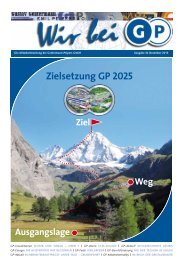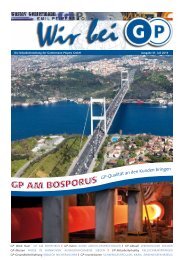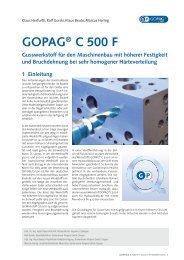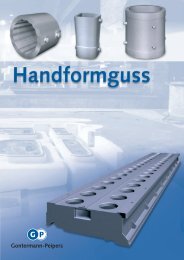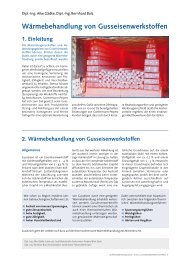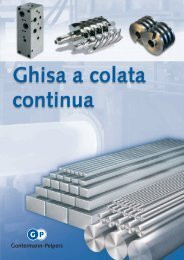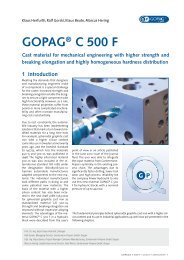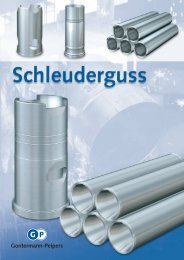Hand Moulding (1.4 mb) - Gontermann-Peipers
Hand Moulding (1.4 mb) - Gontermann-Peipers
Hand Moulding (1.4 mb) - Gontermann-Peipers
You also want an ePaper? Increase the reach of your titles
YUMPU automatically turns print PDFs into web optimized ePapers that Google loves.
<strong>Hand</strong> moulding<br />
Production<br />
GP hand-moulded iron castings<br />
– a good choice<br />
At GP, complex machine parts made of lamellar graphite<br />
or nodular graphite cast iron are manufactured near net<br />
shape with large differences in wall thicknesses using<br />
hand moulding.<br />
Cast iron is an easily machined material and offers advantageous<br />
vibration minimization, damping, and smooth<br />
running and failsafe running characteristics. This permits<br />
quiet running and higher precision with machine tools.<br />
Where cast iron with nodular graphite is concerned, ideal<br />
mechanical characteristics are added to this.<br />
Thus it is highly advisable to use cast iron components by<br />
GP for high quality machines.<br />
GP simulation<br />
At GP, casting and solidification simulations, as well as finite<br />
element analysis, are used when planning the casting<br />
process.<br />
GP dimensions<br />
GP produces hand-moulded castings in made-to-order<br />
production with piece weights of 10 to 160 tons.<br />
For round parts, the casting pits permit lengths of 3 to<br />
9 metres and diameters of 3 to 6 metres.<br />
All other parts can be realized starting from 10 tons finished<br />
weight with dimensions up to 16 metres long,<br />
4 metres wide and 3 metres thick.
Examples of use<br />
Materials<br />
GP produces hand-moulded castings<br />
using the following materials:<br />
■ Lamellar graphite cast iron as per EN 1561<br />
■ Lamellar graphite cast iron as per EN 1563<br />
(See reverse for materials data)<br />
All quality-relevant processes are monitored within the<br />
framework of GP’s quality management program.<br />
Examples of use<br />
■ Machine beds<br />
■ Columns<br />
■ Crossbeams<br />
■ Carriages<br />
■ Tailstock and headstock cases<br />
■ Tables and palettes<br />
■ Bushings<br />
■ Hydraulic blocks<br />
■ Storage and transport containers<br />
■<br />
Mill stands<br />
■ Casting and steelworks moulds.
Preliminary remarks:<br />
■ For hand-moulded castings, GP determines the representative wall thickness according to the dimension as cast.<br />
■ The characteristic property, tensile strength or hardness, should be defined clearly in the purchase order.<br />
■ GP determines the characteristic values from cast-on test pieces. Other types of sampling generally require a separate agreement.<br />
■ Because the specified standards can only be printed in excerpted form in this list, additional standard definitions must be observed.<br />
■ Additionally, DIN-EN 1560 “Designation system for cast iron” and DIN-EN 1559-1 and 1559-3 “Founding, technical conditions of delivery” apply.<br />
Characteristic property:<br />
Tensile strength<br />
Characteristic property:<br />
Brinell hardness<br />
EN 1561 Cast lamellar graphite iron<br />
Excerpt<br />
Material designation Definitive wall Tensile strength R 2) m Tensile<br />
thickness 1) values to be met strength R 4) m<br />
Material code Nu<strong>mb</strong>er mm in separately in integrally expected values in<br />
EN 1561 EN 1561 cast cast samples casting 5)<br />
(prev. DIN 1691) (DIN 1691) samples 3)<br />
from to N/mm 2 N/mm 2 N/mm 2<br />
EN-GJL-200 EN-JL1030 20 40 200 to 300 7) 170 155<br />
(GG-20) (0.6020) 40 80 150 130<br />
80 150 140 115<br />
150 300 130 5) -<br />
EN-GJL-250 EN-JL1040 20 40 250 to 350 7) 210 195<br />
(GG-25) (0.6025) 40 80 190 170<br />
80 150 170 155<br />
150 300 160 5) -<br />
EN-GJL-300 EN-JL1050 20 40 300 to 400 7) 250 240<br />
(GG-30) (0.6030) 40 80 220 210<br />
80 150 210 195<br />
150 300 190 5) -<br />
min.<br />
min.<br />
EN 1561 Cast lamellar graphite iron<br />
Excerpt<br />
Material designation Definitive wall Brinell<br />
thickness 1) hardness 1) 2)<br />
Material code Nu<strong>mb</strong>er mm HB 30<br />
EN 1561 EN 1561<br />
(prev. DIN 1691) (DIN 1691)<br />
from to min. max.<br />
EN-GJL-HB 215 EN-JL2040 40 3) 80 145 215<br />
(GG-220 HB) (0.6027) 20 40 160 235<br />
EN-GJL-HB 235 EN-JL2050 40 3) 80 165 235<br />
(GG-240 HB) (0.6032) 20 40 180 255<br />
EN-GJL-HB 255 EN-JL2060 40 3) 80 185 255<br />
(GG-260 HB) (0.6037) 20 40 200 275<br />
1) and 2) see standard, 3) reference wall thickness for this type<br />
1) to 4) and 7) see standard, 5) recommended values, not mandatory<br />
EN 1563 Cast nodular graphite iron<br />
Excerpt: Mechanical properties<br />
measured using integrally cast samples<br />
Material designation Definitive wall Tensile Tensile Elon- Minimum values for<br />
thickness strength yield gation notch-impact work using<br />
strength A samples with V-notch<br />
Material code Nu<strong>mb</strong>er t R m R p0,2 % Mean value Individual<br />
EN 1563 EN 1563 mm N/mm 2 N/mm 2 from 3 tests value<br />
(prev. DIN 1693) (DIN 1693) min. min. min.<br />
EN-GJS-400-15U EN-JS1072 t ≤ 30 400 250 15<br />
(GGG-40) (0.7040) 30 < t ≤ 60 390 250 14<br />
60 < t ≤ 200 370 240 11<br />
EN-GJS-400-18U EN-JS1062 t ≤ 30 400 250 18<br />
30 < t ≤ 60 390 250 15<br />
60 < t ≤ 200 370 240 12<br />
EN 1563 Cast nodular graphite iron<br />
Excerpt: According to Appendix A of the standard; for use only<br />
by arrangement between the customer and GP<br />
Material designation Brinell Additional properties<br />
hardness (for information only)<br />
range<br />
R m R p0,2<br />
Material code Nu<strong>mb</strong>er HB N/mm 2 N/mm 2<br />
EN-GJS-HB150 EN-JS2020 130 to 175 400 250<br />
EEN-GJS-HB200 EN-JS2050 170 to 230 500 320<br />
EN-GJS-HB230 EN-JS2060 190 to 270 600 370<br />
EN-GJS-HB265 EN-JS2070 225 to 305 700 420<br />
EN-GJS-400-18U-LT EN-JS1049 t ≤ 30 400 240 18<br />
(GGG-40.3) (0.7043) 30 < t ≤ 60 390 230 15 12 J(-20ϒC) 9J(-20ϒC)<br />
60 < t ≤ 200 370 220 12 10 J(-20ϒC) 7J(-20ϒC)<br />
EN-GJS-400-18U-RT EN-JS1059 t ≤ 30 400 250 18<br />
30 < t ≤ 60 390 250 15 14 J (RT) 11 J (RT)<br />
60 < t ≤ 200 370 240 12 12 J (RT) 9 J (RT)<br />
EN-GJS-500-7U EN-JS1082 t ≤ 30 500 320 7<br />
(GGG-50) (0.7050) 30 < t ≤ 60 450 300 7<br />
60 < t ≤ 200 420 290 5<br />
EN-GJS-600-3U EN-JS1092 t ≤ 30 600 370 3<br />
(GGG-60) (0.7060) 30 < t ≤ 60 600 360 2<br />
60 < t ≤ 200 550 340 1<br />
EN-GJS-700-2U EN-JS1102 t ≤ 30 700 420 2<br />
(GGG-70) (0.7070) 30 < t ≤ 60 700 400 2<br />
60 < t ≤ 200 660 380 1<br />
Mechanical properties for deviant wall thicknesses are subject to arrangement between<br />
the customer and GP.<br />
If tensile strength properties are required in addition to hardness,<br />
then these shall be agreed upon between the customer and GP;<br />
the same shall apply for the test position. Saving an agreement to<br />
the contrary, the test shall be made at a representative position of<br />
our choosing.<br />
The characteristic property “hardness” does not exist in the former<br />
standard DIN 1693.<br />
(Excerpts of standards reproduced with the permission of DIN Deutsches Institut für Normung e.V. [German Institute for Standardization].<br />
Decisive for the application of the standards is the version with the latest date of publication which is available from Beuth Verlag G<strong>mb</strong>H, Burggrafenstraße 6, 10787 Berlin.)




